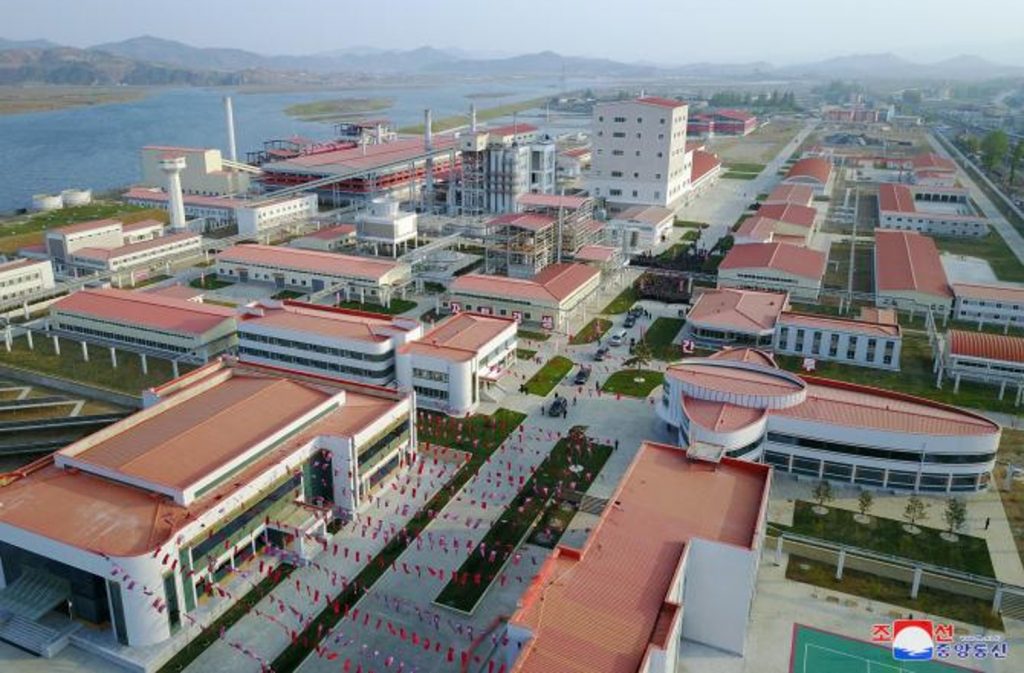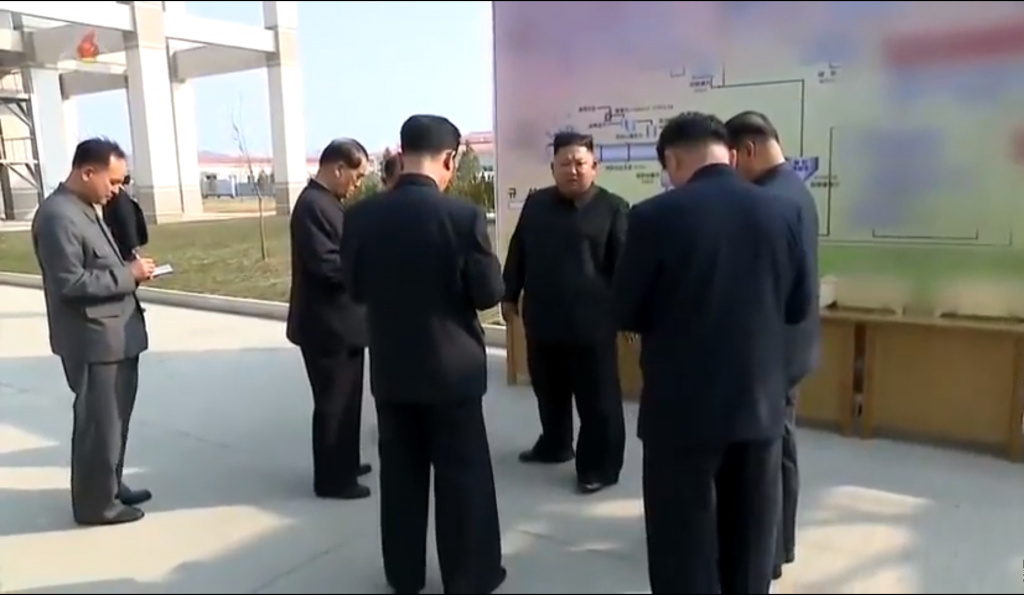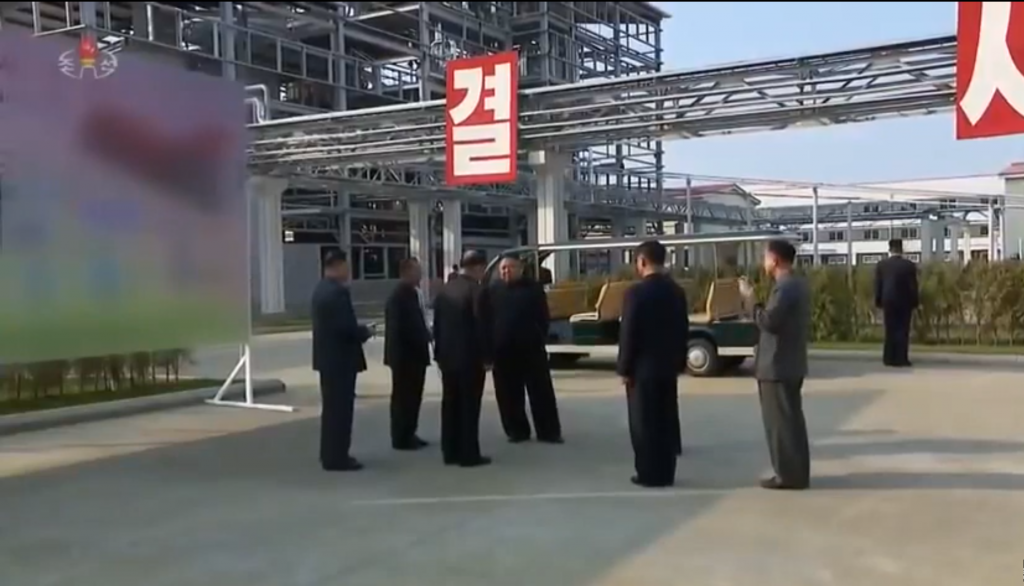Does the Sunchon Phosphatic Fertilizer Plant Produce Uranium: Not Likely
On May 1, 2020, Kim Jong Un appeared after a three-week absence to oversee the opening of the Sunchon Phosphatic Fertilizer Factory. North Korea’s party newspaper, Rodong Sinmun, hailed the factory’s completion as a “gunfire signaling the first victory” in its “frontal breakthrough” in the face of the country’s economic difficulties and when prospects of United Nations sanctions relief appeared to be evaporating.
Figure 1. The new Sunchon Phosphatic Fertilizer Factory compound consists of several facilities.[1]

The extensive coverage of the factory’s opening in North Korean media reflects the high importance the regime has placed on this facility. The language of their message suggests the new facility is perhaps intended to help calm concerns about shortages of imported seeds and fertilizers, and the potential impact it will have on food security in the coming years.
There has also been wide speculation that this new fertilizer plant is to be used to recover uranium as a by-product from ores to contribute to its fissile material production program.[2] However, based on information gleaned from the numerous pictures and videos of the new factory and the production processes it is equipped to use, it seems more likely that the factory is designed to produce both fertilizer and other chemical compounds with military and civilian applications.
Production of Fertilizers
The current fertilizer factory is built on the site of the old Sunchon Lime Nitrogen Fertilizer Plant (순천석화질소비료공장).[3] On May 14, 2017, an opening ceremony was held at the Sunchon site signaling the beginning of a new national initiative to build a “C1 chemical industry.”
In simple terms, C1 chemistry involves converting carbon compounds into other useful products that can have a variety of uses ranging from synthetic fuels to key industrial chemicals and fertilizers for agricultural use. Nearby limestone and anthracite mines provide a source for coal as a raw material required for the C1 industry.
Production of fertilizers from phosphates proceeds in three steps: acquisition of phosphate-rich ore, production of phosphoric acid from the ore and use of phosphoric acid to produce various fertilizers.
Reports indicate that the Sunchon complex is designed to run two different processes for the production of phosphoric acid: a wet process and a dry process.[4]
In a wet process, which is the most commonly used method globally, phosphoric acid is produced by adding sulfuric acid into pulverized phosphate-containing rock. Impurities in the resulting phosphoric acid are then removed by solvent extraction or ion exchange before converting it to a phosphate compound. It is through this purification phase that uranium can be recovered.
Figure 2. A partially-censored process diagram at Sunchon reveals an anthracite coal drying furnace and silica ore (in Korean). These elements point to planning for a dry process for the production of phosphor-containing chemical compounds.[5]

However, a blurred partial diagram in Figure 2 displayed at the Sunchon factory also shows the use of a dry process. In a dry, thermal process, phosphate rock, silicate (sand) and coke (anthracite) are fed continuously into an electric arc furnace at 2,000 degrees Celsius, which produces white phosphorus and slag. White phosphorus is then separated from slag and burned to tetraphosphorus decaoxide, after which, when treated with water, results in phosphoric acid. White phosphorus can also be used to produce a variety of other phosphor compounds. When treated with ammonia, it can produce ammonium phosphate, a common fertilizer.
A dry process is a more energy-consuming and expensive way to produce phosphoric acid. However, its intermediate product, white phosphorus, which is not obtained in a wet process, is also a precursor for military products including illuminating munitions, smoke screening grenades or ammunition, as well as for a number of civilian applications such as in electronics, medicine and food industries.
Whether the blurring of some of the diagrams in Figure 2 indicates a dry process scheme that can be attributed to possible military applications remains unknown. It is also unclear whether the wet process, which is also more suitable for uranium recovery, is the actual process that will be used to produce the ammonium phosphate.
Figure 3. Most of the images indicating the designs of chemical processes at Sunchon have been censored to conceal details of activities of the site.[6]

It is worth noting that the wet and dry process facilities were planned and constructed by separate entities. The construction of the dry production process building was led by the Gangsun Industry Construction Office, while the ammonium phosphate fertilizer plant was built by the Bongsan Chemical Construction Office. Given this distinction, it can be assessed that the wet process is used to produce fertilizers while the high purity dry process is expected to be used for other military and civilian applications.
Does North Korea Need More Uranium Mining and Milling Capacity?
Suspicions that North Korea may use the new Sunchon complex to extract uranium for its nuclear program are built around the assumption that the country needs greater uranium mining and milling capacity. However, there is little evidence to support this assumption.
In 1992, North Korea provided the International Atomic Energy Agency with a letter[7] disclosing that it had two known uranium mines (the Wolbisan and Pyongsan Uranium Mines) and two milling facilities (the Pakchon Uranium Concentrate Pilot Plant and the Pyongsan Uranium Concentrate Plant.) The Pyongsan Plant has, according to the IAEA, been operating recently.
However, when high-level North Korean officials have visited various industrial sites in recent years, they have repeatedly emphasized the need to develop further mining capabilities at the Pungnyon, Joongsan and Yongyu Mines that appear to be rich in phosphate-containing ores usually containing some uranium. Whether they will be utilized also for the recovery of uranium remains to be seen.
In assessing the country’s current and past uranium needs, there are three major demands: 1) fuel for its 5 MWe gas-cooled-graphite-moderated reactor and the Experimental Light Water Reactor still under construction along with some research facilities; 2) its exports to Libya, Pakistan and possibly to Syria; and 3) the production of highly enriched uranium for its nuclear weapons program.
Prior to the Agreed Framework of 1994, which froze North Korea’s plutonium production program, the North historically produced enough uranium for the nine known reactor core loads and spare stocks for the 5 MWe Reactor—around 500 tons of uranium. Such figures are consistent with the uranium production capabilities of the mines and milling facilities North Korea disclosed in 1992. Since the Agreed Framework, the known fuel conversion facility at Yongbyon has not operated and is no longer in operational condition.
The estimated inventory of highly enriched uranium varies from widely from 200-700 kilograms depending on assumed uranium enrichment capacity.[8]
Given these metrics, the production capacity of Pyongsan and possibly Pakchon over the last 25 years has been sufficient to cover the bulk of uranium required for both the North’s civilian and weapons programs. In addition, North Korea has exported small amounts of uranium hexafluoride (UF6) to Pakistan and Libya.
The key issue today is the scope of North Korea’s actual uranium conversion and enrichment capabilities. Pyongyang restarted its enrichment activities by the mid-1990s. Its first centrifuges with small amounts of uranium hexafluoride were provided by Pakistan. Based on other countries’ experiences with similar enrichment programs, North Korea should have been able to have a pilot enrichment plant by mid-2000, and a small demonstration-scale plant by 2010.
While no pilot enrichment plant has been declared, North Korea revealed its demonstration-scale plant at Yongbyon in 2010, and has subsequently doubled the size of its centrifuge hall. This plant likely has the capacity to meet the low-enriched uranium requirements of the Experimental Light Water Reactor under construction. However, to produce 200 kilograms or more highly enriched uranium for the nuclear weapons program, substantial additional enrichment capacity is required. What is also missing from the picture is an annual 100-200 ton natural UF6 conversion capacity required to support such a program.
Conclusion
Uranium extraction from the apatite ores used at Sunchon through a wet production process of phosphoric acid is a straightforward process and, therefore, there is no reason to discount the possibility that uranium in the form of yellowcake could be one of Sunchon’s products. However, there are no telltale signs gleaned from satellite imagery or other information available to suggest this is what is taking place. From a big-picture perspective, North Korea does not have a desperate need to extract uranium from every facility capable of doing so—the bottleneck in their nuclear program is likely on the enrichment side of the equation, not the production of yellowcake. Instead, there is reason to believe that if a dry production process for fertilizers is planned for use, this could support numerous civilian and other non-nuclear military applications.
- [1]
“Supreme Leader Kim Jong Un Cuts Tape for Completion of Sunchon Phosphatic Fertilizer Factory,” Kim Il Sung University (originally cited from KCNA), May 2, 2020, http://www.ryongnamsan.edu.kp/univ/en/revolution_activity/47d1e990583c9c67424d369f3414728e.
- [2]
See: Melissa Hanham, Grace Liu, Joseph Rodgers, Mackenzie Best, Scott Milne, and Octave Lepinard, “Monitoring Uranium Mining and Milling in China and North Korea through Remote Sensing Imagery,” (occasional paper 40, James Martin Center for Nonproliferation Studies, Middlebury Institute of International Studies at Monterey, October 2018), https://www.nonproliferation.org/wp-content/uploads/2018/10/op40-monitoring-uranium-mining-and-milling-in-china-and-north-korea-through-remote-sensing-imagery.pdf; David von Hippel, “Methods for Refining Estimates of Cumulative DPRK Uranium Production,” The Nautilus Institute, NAPSNet Special Reports, May 27, 2019, https://nautilus.org/napsnet/napsnet-special-reports/methods-for-refining-estimates-of-cumulative-dprk-uranium-production/; and Margaret Croy, “Dual Use in the DPRK: Uranium Extraction from Phosphate Fertilizer Factories,” (occasional paper 47, James Martin Center for Nonproliferation Studies, Middlebury Institute of International Studies at Monterey, April 2020), https://www.nonproliferation.org/wp-content/uploads/2020/04/Dual-Use-in-the-DPRK.pdf.
- [3]
The article originally stated that this was built on the site of the old Sunchon Chemical Complex, also known as the Sunchon Vinalon Complex, which produced fertilizers, carbides and polyvinyl. This was corrected on July 2, 2020. The Sunchon Vinalon Complex is being converted into the “Construction Project for Building C1 Chemical Industry”. This is located at 39.410056°, 125.987760°.
- [4]
See 안윤석, “北 평안남도 순천인비료공장 준공 박두…‘인(燐)자원 가치 다시 주목 받아,’” Seoul Pyongyang News, April 20, 2020, http://www.spnews.co.kr/news/articleView.html?idxno=27674; and Korean Central Television video footage of the Sunchon Phosphatic Fertilizer Factory, May 2, 2020.
- [5]
See Jeongmin Kim, “North Korean media lauds new fertilizer factory, rejects ‘reform and opening,’” NK News, May 5, 2020, https://www.nknews.org/2020/05/north-korean-media-lauds-new-fertilizer-factory-rejects-reform-and-opening/; and Korean Central Television video footage of the Sunchon Phosphatic Fertilizer Factory, May 2, 2020.
- [6]
Ibid. It was reported that the reconstruction of the Sunchon complex was led by Mr. Pak Pong Ju, Vice Chairman of the State Affairs Commission of the Democratic People’s Republic of Korea and the Vice Chairman of the Party Central Committee, and Mr. Choe Do Jung, both of whom spoke at the opening ceremony on May 1. Mr. Pak has been one of the key architects in implementing the byungjin policy to simultaneously develop the military nuclear program and the economy. In addition to Kim Jong Un, the ribbon-cutting event included other high-level participants including Prime Minister Kim Jae Ryong of the Chosun Workers’ Party Central Committee Political Bureau and Chosun Democratic People’s Republic of Korea Commission of State, Chosun Workers’ Party Central Committee Deputy Directors Kim Duk Hoon and Park Tae Sung, and Chosun Workers’ Party Central Committee First Deputy Directors Kim Yo Jong and Jo Yong Won.
- [7]
“List of Nuclear Facilities Related to Nuclear Industry,” letter of Choi Hak Gun, Minister of Atomic Energy of the DPRK to IAEA Director General, International Atomic Energy Agency, May 1, 1992.
- [8]
See David Albright, “North Korea’s Nuclear Capabilities: A Fresh Look, Institute for Science and International Security,” Institute for Science and International Security, August 9, 2017, https://isis-online.org/uploads/isis-reports/documents/North_Korea_Talk_April_28_2017_Final.pdf; and Siegfried S. Hecker, Chaim Braun and Chris Lawrence, “North Korea’s Stockpiles of Fissile Material,” Korea Observer, 47, no. 4 (Winter 2016): 721-749,http://www.iks.or.kr/rankup_module/rankup_board/attach/vol47no4/14833231665766.pdf.
